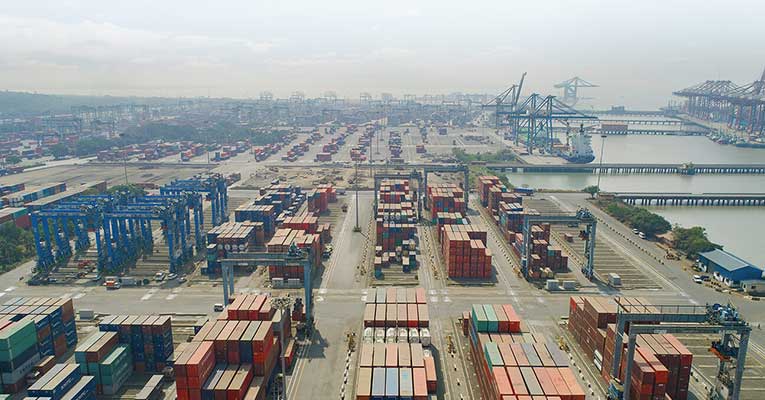Our goal is to make Indian ports globally competitive: IPA
Dr Abhijit Singh, executive director, Indian Ports Association (IPA) talks about how the Indian government is keen on making Indian Ports more competitive globally. Ease of Doing Business and challenges faced by Indian ports

Dr Abhijit Singh, executive director, Indian Ports Association (IPA) talks about how the Indian government is keen on making Indian Ports more competitive globally.
Ease of Doing Business and challenges faced by Indian ports
As per the latest Ease of Doing Business Ranking (Doing Business 2020) released by World Bank, India ranked 63 among 190 countries. India has leapt 14 ranks over its rank of 77 in the DBR 2019. Back in 2015, India was ranked 142. Ease of Doing Business (EoDB) ranking is calculated based on 10 different Indicators such as getting electricity, getting credit, enforcing contracts etc. As far as the Ministry of Shipping and ports are considered, it has a huge role to play in improving the Trading Across Border indicator ranking thus impacting overall EoDB ranking. Currently, India is ranked 68 on Trading Across Borders Indicator.
Trading Across Borders Indicator records the time and cost associated with the logistical process of exporting and importing goods. It measures the time and cost (excluding tariffs) associated with three sets of procedures—documentary compliance, border compliance and domestic transport—within the overall process of exporting or importing a shipment of goods. Number of measures like modernisation, mechanisation and digital transformation such as Direct Port Delivery, Direct Port Entry, Port Community System (PCS1x), installation of container scanners and RFID (Radio-Frequency Identification)system, doing away with manual forms etc. have been taken to reduce time and cost in EXIM trade and improve Ease of Doing Business
Major ports are working vigorously in implementing such digital high-tech solutions to ease the flow of cargo from the ports. The major challenge is taking all the stakeholders on-board to make the whole ecosystem work efficiently. We are continuously organizing roadshows and stakeholder meetings & consultations to overcome this challenge so that every stakeholder understand the system and see huge value in adopting the same.
Potential of domestic cruise tourism and Government initiatives
The Ministry of Shipping has turned its focus towards maritime tourism to promote domestic and international tourism. Some of the recent steps to rekindle the sector include:
- A national roadmap for the development of cruise tourism has been made through an internationally renowned consultant, which has projected the possibility of phenomenal growth over 25 years in the number of passengers from 0.2 million in 2016 to 4 million in 2041, increase in ship calls from 166 to 955 and passengers per ship from 1200 to 4100, employment potential of 2,50,000 persons from the existing 5000 persons and economic potential of Rs. 35,500 crores compared to Rs. 712 crores in 2016.
- Currently, ports of Mumbai, Goa, New Mangalore, Cochin and Chennai are primarily the ports of call for cruise lines. However, Coasta New Classica cruise has made Mumbai a homeport in 2017 – 18 and 2018 – 19.
- Besides, India’ domestic Cruise Ship Angriya, with best-in-class amenities, has commenced operations between Mumbai and Goa on every alternate day. So far, this cruise ship has made 64 calls at each of the ports of Mumbai and Goa and 55798 passengers have been handled during 2018 – 19.
- A task force under the joint Chairmanship of Secretary (Shipping) and Secretary (Tourism) was constituted in November 2015 for coordinated efforts to create an enabling eco-system for the development of cruise tourism in India
- Standard operating procedures (S0Ps) have been Standard operating procedures (S0Ps) have been Major Ports. A monitoring committee has been constituted to ensure smooth implementation of S0Ps
- Foreign flag cruise vessels have been allowed to call at Indian ports without obtaining a license from DGS and this facility has been extended until February 05, 2024
- To make India attractive to cruise passengers and to promote cruise tourism, e-visa procedure has been streamlined for quick immigration clearance. Passengers arriving with e-visa have been exempted from the requirement of biometrics
- Port charges have been rationalized at all major ports to attract cruise ships
- Port-level committees under the respective major ports’ chairmen have been constituted to address manpower, coordination and logistic issues
- Cruise terminals with modern facilities have been constructed/being constructed at the five major ports as mentioned above.
Sustainability of the PPP model
PPPs are contractual means to deliver public assets and public services. A contract may fail for many reasons. A good number of them are naturally related to the PPP characteristics and even to the essence of the project itself. But the contract should be ready to tackle many risks which can affect a project and are unavoidable most effectively and efficiently. PPP fails when it does not properly allow the parties to deal with such circumstances; this creates unbalanced situations or produces early contract terminations that could otherwise have been avoided.
Also, value for money has to be protected and maximized through the preparation and implementation process, and throughout the life of the contract. This involves proper management of the process, with suitable capabilities and resources, as well as the need to follow standard approaches and good practices. To make PPP model sustainable for ports, government over the years has been continuously reforming the policies and guidelines in consultation with all the stakeholders and has been very empathic to the need and demands of the private sector. Already the government has amended the Model Concession Agreement which was approved by the Cabinet during January 2018 to obviate the problems being faced in execution of PPP Projects on account of certain provisions of the earlier MCA. Also, the government is drafting guidelines for dealing with Stressed PPP Projects at Major ports.
Factors that will enhance global EXIM trade through Indian ports
Various factors can enhance the global EXIM trade through Indian ports. For example, bilateral and multilateral FTAs can boost the EXIM trade through Indian ports. Due to such agreements, India is exporting a huge number of automobiles to Africa and Latin America. China’s increasing labour cost and growing trade frictions with America can lead to shifting of manufacturing facilities to India by global manufacturing players which can enhance exports through Indian ports.
The anticipated increase in demand in consumption of petroleum production, coal, natural gas for power generation and fertilizer industry, production of steel, fertilizer imports etc. leads to an increase in imports through the ports. Similarly, the anticipated increase in surplus exportable items leads to an increase in exports. Growth in container traffic is envisaged to international trade growth, penetration of containerization and hub and feeder service structure.
Further, measures taken for improving efficiency and reducing the time to export through technology can boost trade through Indian ports. Rationalizing the tariff structure and discount methods at Major ports can also have a huge impact on the growth of EXIM trade at these ports.
Ship Recycling Act will increase the brand value of our Ships Recycling Yards located at Alang in Gujarat, Mumbai Port, Kolkata Port & Azhikkal in Kerala
The Ship Recycling Act, 2019 ensures environment-friendly recycling process of Ships and adequate safety of the yard workers. This Act paves the way for more global ships to enter into Indian Shipyards for recycling and boost employment and business opportunities. Now, ships to be recycled in India will need to obtain a ‘Ready for Recycling Certificate’ under the Hong Kong Convention. Hoping for increased business, a large number of Recycling plots, especially at Alang in Gujarat, are also gearing up and obtaining Statement of Compliance (SOC) with the Hong Kong Convention. India is a leader in the global ship recycling industry with a share of over 30 per cent of the global market. After this act the share is expected to grow up to 60% in coming years as countries which earlier didn’t use to send their ships to India for recycling, citing environmental and safety concerns, will start doing so. Thus, this Act will increase the brand value of Ship Recycling yards of India.
Activities currently in the pipeline to push the idea of port-led development
There is a slew of projects in the pipeline under the port-led development programme. Some of them are as under:
- More than 600 projects are under Sagaramala Programme which is under different stages of development, implementation and completion with a total investment of more than 8.5 lakh crores
- Around 90+ projects worth about 15000 crore rupees have already been completed and balance projects are to completed in stages by 2035
- All these projects focus across the areas of port modernization & new port development, port connectivity enhancement, port-linked industrialization and coastal community development
- Development of world-class, deep-draft container port at Vadhavan (15 Berths with total length 8680m and 2 SPMs)
- Development of deepwater terminal in the eastern coast capable of handling super cape size vessels and adopting international norms in the bulk carrier in Paradip port
- Developing western dock in Paradip ports with the deep draft (20-22.5 m) for handling dry bulk capsize vessels (1.8-2.0 lakh DWT).
- Development of 2 new berths and mechanization of 3 berths at Paradip with an estimated cost of 2800 Cr with additional capacity of 50MMTPA.
- Govt is reorienting ports like Mumbai, Goa & Chennai from cargo handling port to the hub of cruise and recreational tourism.
Government support to ensure ports’ growth
The priority for the government and ports is to expedite on-going projects and bring in more investments into port-led development programme under Sagarmala. Also, the major ports are taking a huge leap in digitization and automation transformation. These measures would help Indian Major Ports compete with global ports and facilitate both EXIM and domestic trade.
To ensure the efficient and expeditious working of major ports, it is very necessary to overhaul the administrative setup of the port trusts. The Government is pushing for a new ‘Major Port Authorities Bill’ to pass from the Parliament to modernize the institutional structure of the Major Ports so that they are in a position to perform efficiently in the competitive port sector and provide greater autonomy to Ports. I expect this would be done in the next session of parliament. Further, the government needs to make efforts and come up with a coherent policy for expediting long-pending environmental clearances for projects taking along the state governments as per the NGT guidelines. Delay in such clearances not only affect the project implementation but also dampens the investors’ confidence.
 Dr Abhijit Singh is the executive director of IPA, an association that acts as a think tank to the Ministry of Shipping, and also hailed as the Centre of Excellence (CoE) helping major ports achieve eminence in their operations & management thus contributing to the growth of the economy and the country at large.
Dr Abhijit Singh is the executive director of IPA, an association that acts as a think tank to the Ministry of Shipping, and also hailed as the Centre of Excellence (CoE) helping major ports achieve eminence in their operations & management thus contributing to the growth of the economy and the country at large.
The views and opinions expressed in this article are those of the author and do not necessarily reflect the views of Indian Transport & Logistics News.



